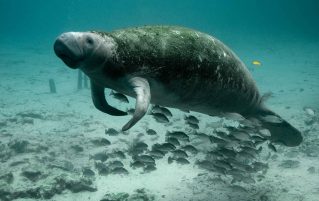

You will learn all about noble gases in school, but what do you know about the gases animals emit?
You probably already know from science lessons that cows give off a lot of methane gas. But apparently, just one cow emits enough gas in a single day to fill around 400 litre bottles! It is not just cows which produce and emit methane. The Bolson pupfish is a freshwater fish, found in Mexico. It eats algae, and when doing so also takes in bubbles of gas which the algae produce. All these gas bubbles inflate their intestines and cause them to float. Imagine being a fish floating on the surface of the water, completely exposed to predation by birds. In order to survive the fish has to bury itself in sand and fart out the gas!! If they don’t, they risk being eaten, or having their intestines rupture from the pressure of trapped gas!
Manatees, sometimes referred to as sea cows, rely on digestive gases to keep them afloat. They have gas pouches in their intestines to store the gas. Lots of gas makes them buoyant, and helps them float to the water surface. However, if they want to sink back down, they release the gas. In this way they control their movement, and stay horizontal through the water.
GCSE Scientists – you need to be able to explain the properties of the Noble Gases. For help with this try our new guide “How to work with the Noble Gases”. It includes questions to try, and answers to check your understanding.
Click on the picture below to see the guide.
If you found this useful and think you would benefit from some additional help, please contact us.
